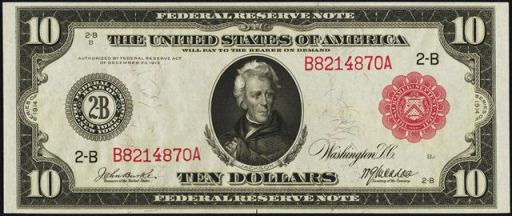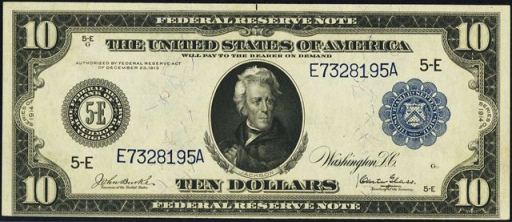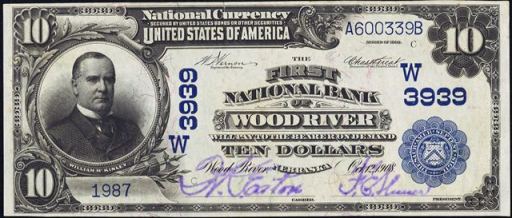The 1910s saw the creation of what is now the only type of paper money issued by The United States, aka, the Federal Reserve note. In fact, the only other type of money printed during that time range (1910-1919) were national bank notes (and the very similar Federal Reserve Bank notes).
First off, you need to know that there are two similar types of ten dollar federal reserve notes. Both are issued for the series of 1914. One type has a red seal and the other has a blue seal. Blue seals are much much more common, probably by a factor of 50 to 1. Blue seals can still be valuable. Being in perfect condition or having a star in the serial number can help increase the value. Any time a serial number is under 100 then it will also command a premium. All ten dollar bills of this type feature a portrait of Andrew Jackson.


Federal Reserve bank notes look very similar to just regular federal reserve notes. The biggest difference is that Andrew Jackson is on the left hand side of the bill instead of at the center. These $10 bills can be issued for 1915 or 1918. Some are very rare. A few types even come as star notes – and those are exceedingly (like buy a new car) rare.

As with all other decades, ten dollar national bank notes were being printed in the 1910s. All bank notes will have “Series of 1902” written on them. However, they will likely also say 1910, 1911, 1912, 1913, 1914, 1915, 1916, 1917, 1918, or 1919. Those dates correspond to the opening date of the bank, or to when the bank was rechartered for twenty years. When it comes to values, none of those years matter. It is all about the bank, condition, and serial number. Some $10 bills can be worth thousands of dollars.

Don’t be afraid to ask our opinion. We buy lots of ten dollar bills, especially from the 1910s. We are experts so we can tell you exactly what your bill is worth and what we can pay. Just send us an email with pictures and we can go from there. Sales@AntiqueMoney.com


